xcPROC Should CostData
CostData for Should Costing
xcPROC is a structured database that supports xcPEP users with input data required for costing. It is curated by our own data research team and updated quarterly so xcPEP users have access to realistic and current input data.
xcPROC is a data & insights platform.
xcPROC is a data and insights platform built around structured databases used for cost estimation and supplier evaluation.
It includes seven core datasets: raw materials, machines, operations, labour, standard parts, suppliers, and currency. These datasets form the foundation of all should-cost models in xcPEP, enabling accurate cost estimation without relying on generic averages or static reference tables.
Unlike fixed-format databases, xcPROC is actively maintained by ASI’s internal research team and expands continuously. Updates are driven by real project requirements, and custom datasets are developed when clients need support for specific parts, processes, or geographies. This makes xcPROC a dynamic, engineering-led alternative to static cost datasets provided by conventional platforms.
xcPROC is a vendor discovery and evaluation platform.
xcPROC has supplier profiles that show manufacturing capability, business information, and financial data in a clear structured format.
Known and potential parts are mapped for each supplier based on production history and process-level analysis. Profiles also include customer associations, certifications, and downloadable product catalogues. Business sections cover revenue, plant locations, director details, and open financial charges—supporting both technical fitment and risk evaluation. This combination of data supports supplier shortlisting, risk evaluation, and sourcing decisions—all within the same system. The data is curated and maintained by ASI’s internal research team.
xcPROC is a marketplace.
xcPROC is a part-level marketplace that supports the evaluation and procurement of mechanical and electrical components.
Each listed part includes detailed technical specifications, price–quantity data, and ordering options linked to a known manufacturer. Potential manufacturers are also mapped through capability analysis based on machines, processes, and other production parameters. This allows sourcing teams to identify feasible alternatives without restarting supplier evaluation. All orders placed through the platform are fulfilled by the ASI team. The database is regularly updated, with new listings added by ASI data research team.
Explore Data on xcPROC
ASI Data Research Team
Our war on generic data
What is a generic database and why do we dislike it so much?
Generic datasets rely on assumptions and broad averages that ignore how parts are actually made. They often simplify cost inputs to fit fixed templates, which leads to estimates that do not match real manufacturing conditions.
In cost engineering, even small differences can change the outcome. When the input data lacks specificity, the costing becomes guesswork. This is why ASI avoids generic datasets and built xcPROC as a structured database so that cost models reflect actual manufacturing conditions, not assumptions.
What is ASI's approach?
ASI’s approach is to build and maintain its own centralized data platform—xcPROC—to support cost estimation and supplier evaluation. Instead of relying on third-party generic sources, ASI creates structured datasets in-house, tailored to reflect actual manufacturing conditions. When existing data does not cover a specific part, process, or geography, a new dataset is developed from scratch.
ASI’s approach is to build and maintain its own centralized data platform—xcPROC—to support cost estimation and supplier evaluation. Instead of relying on third-party generic sources, ASI creates structured datasets in-house, tailored to reflect actual manufacturing conditions. When existing data does not cover a specific part, process, or geography, a new dataset is developed from scratch.
How xcPROC powers xcPEP’s should-costing models ?
xcPROC serves as the data backbone for xcPEP, ASI’s should-costing platform. Every cost model built in xcPEP draws its inputs from xcPROC' s structured datasets—covering raw materials, machines, operations, labour, standard parts, and suppliers.
This integration ensures that cost estimates reflect real production parameters rather than assumptions or static references. When xcPEP is deployed in new projects, xcPROC evolves alongside it—new data is added, existing values are validated, and client-specific requirements are incorporated.
Database Components
Vast Library and Customer Specific Customizations
Supplier Database
The supplier database in xcPROC provides structured profiles for each listed manufacturer, combining technical capability and business information in one view. Each profile includes known and potential parts, plant locations, certifications, customer associations, product catalogues, financial metrics, and director-level information. This enables sourcing and cost engineering teams to evaluate vendors based on both capability fitment and commercial standing. By consolidating key evaluation parameters, the database supports vendor discovery, shortlisting, and supplier risk analysis—all from a single, searchable interface.
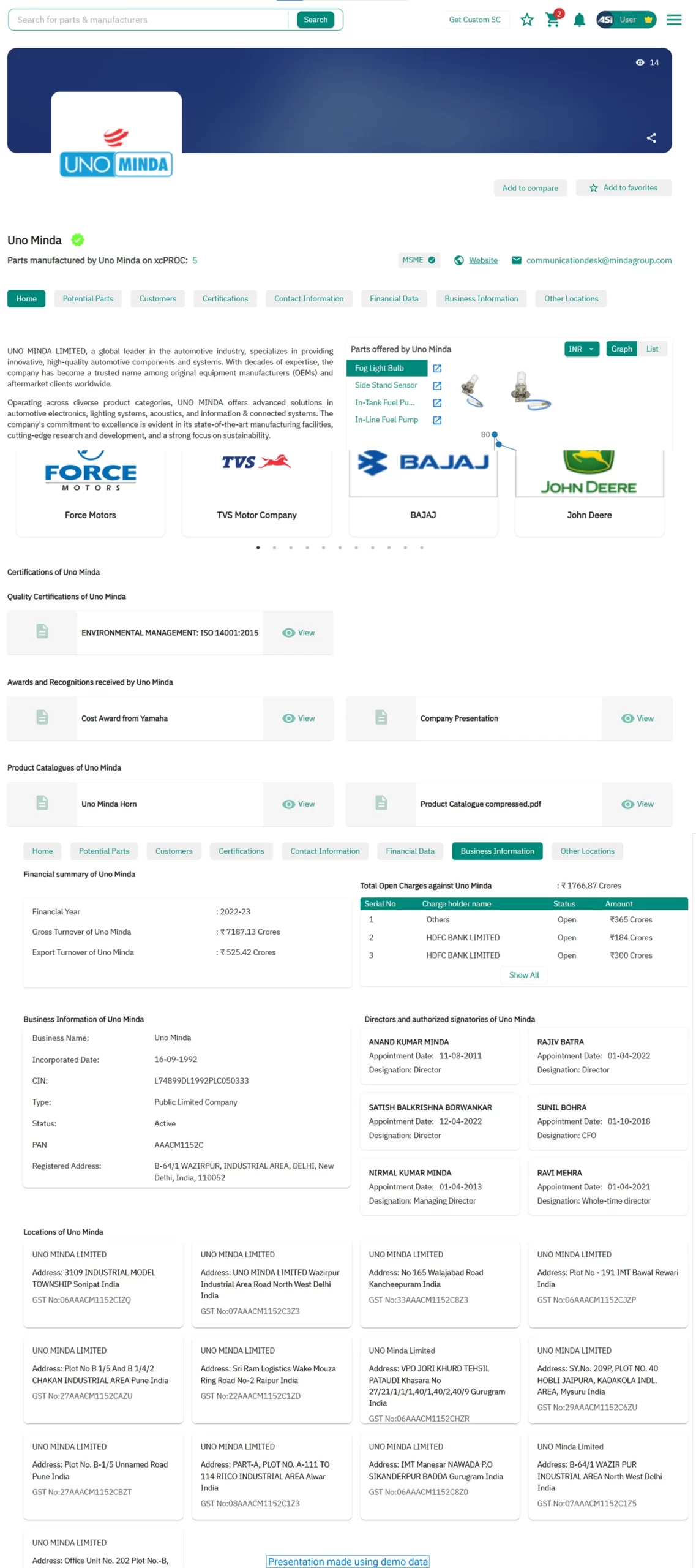
Mechanical Part Database
The Mechanical Part Database in xcPROC contains structured information on standard and bought-out mechanical components such as fasteners, bearings, housings, seals, and brackets. Each entry includes dimensional specifications, material details, weight, and associated manufacturing attributes. The database is primarily used to support BOM-level cost estimation, enable alternate part identification, and streamline sourcing workflows. Users can view supplier-linked listings and place direct orders through the same interface. This dataset is actively maintained and is especially valuable for cost engineers, sourcing teams, and design engineers working on part-level benchmarking and procurement.
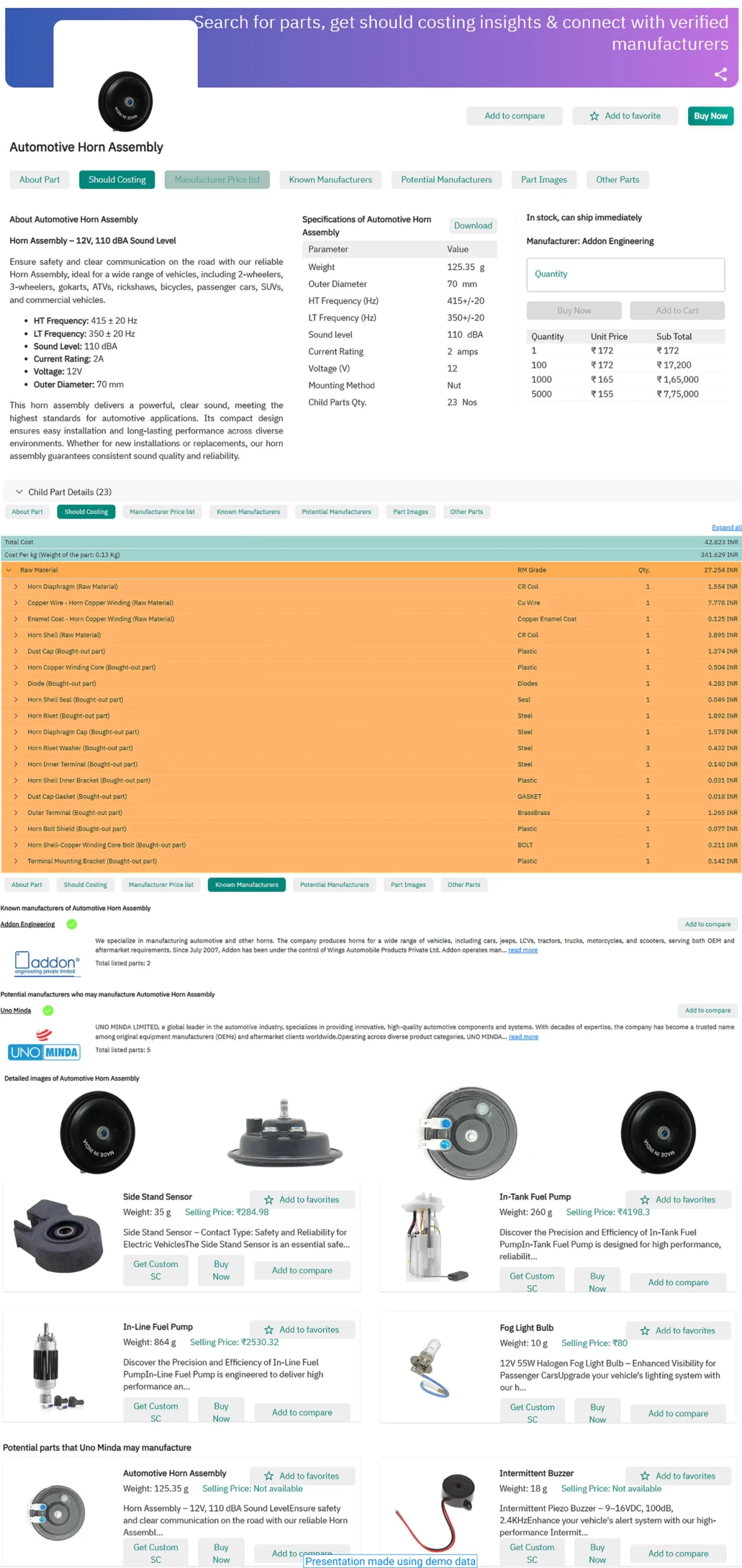
Electronic Part Database
The Electronic Part Database contains a growing set of standard, bought-out components used in PCBAs, harnesses, and electronic assemblies. It includes resistors, capacitors, connectors, sensors, relays, ICs, and other frequently sourced parts across appliances, electronics, and automotive systems. Each entry provides technical specifications such as electrical ratings, packaging type, and material details, along with part weight and typical application. This database supports detailed cost estimation in PCBA-level should-costing, alternate part identification, and teardown analysis. Where applicable, supplier links are included, and direct procurement is enabled through xcPROC. The dataset is continuously updated to reflect current industry usage and is especially relevant for engineering and sourcing teams working with embedded electronics or electro-mechanical systems.
Raw Material Database
The Raw Material Database contains structured data for a wide range of materials used in manufacturing. Each entry includes material grade, sub-grade, initial shape, density, and cost per unit, along with the corresponding currency. This data allows cost models to reflect real-world sourcing conditions and material usage. It is primarily used in costing, alternate material evaluations, and benchmarking within xcPEP. All values are regularly updated to reflect region-specific sourcing and are maintained by ASI’s internal data research team.
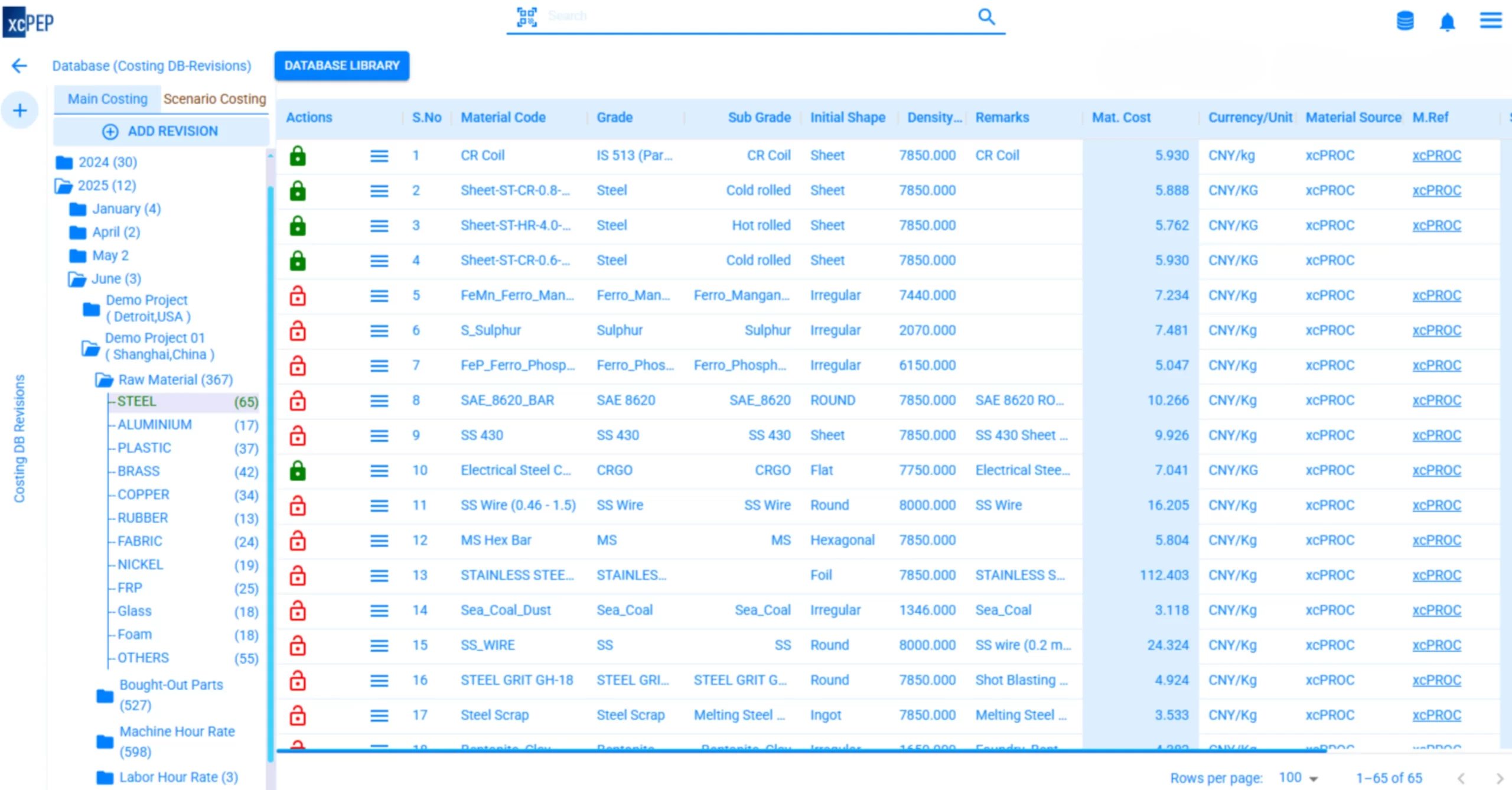
Machine Database
The Machine Database contains structured cost parameters for manufacturing equipment across machining, forming, molding, and fabrication operations. Each machine entry includes brand, operation type, capital and rental costs, installation assumptions, and utility consumption. It also factors in productivity variables such as feed rate, uptime, and life, enabling precise calculation of the machine hour rate (MHR). This MHR serves as a foundational input in xcPEP for estimating operation-wise part costs and comparing routing options. The data is used in operation-level routing analysis within xcPEP and allows users to compare machine options across geography, process efficiency, and cost.
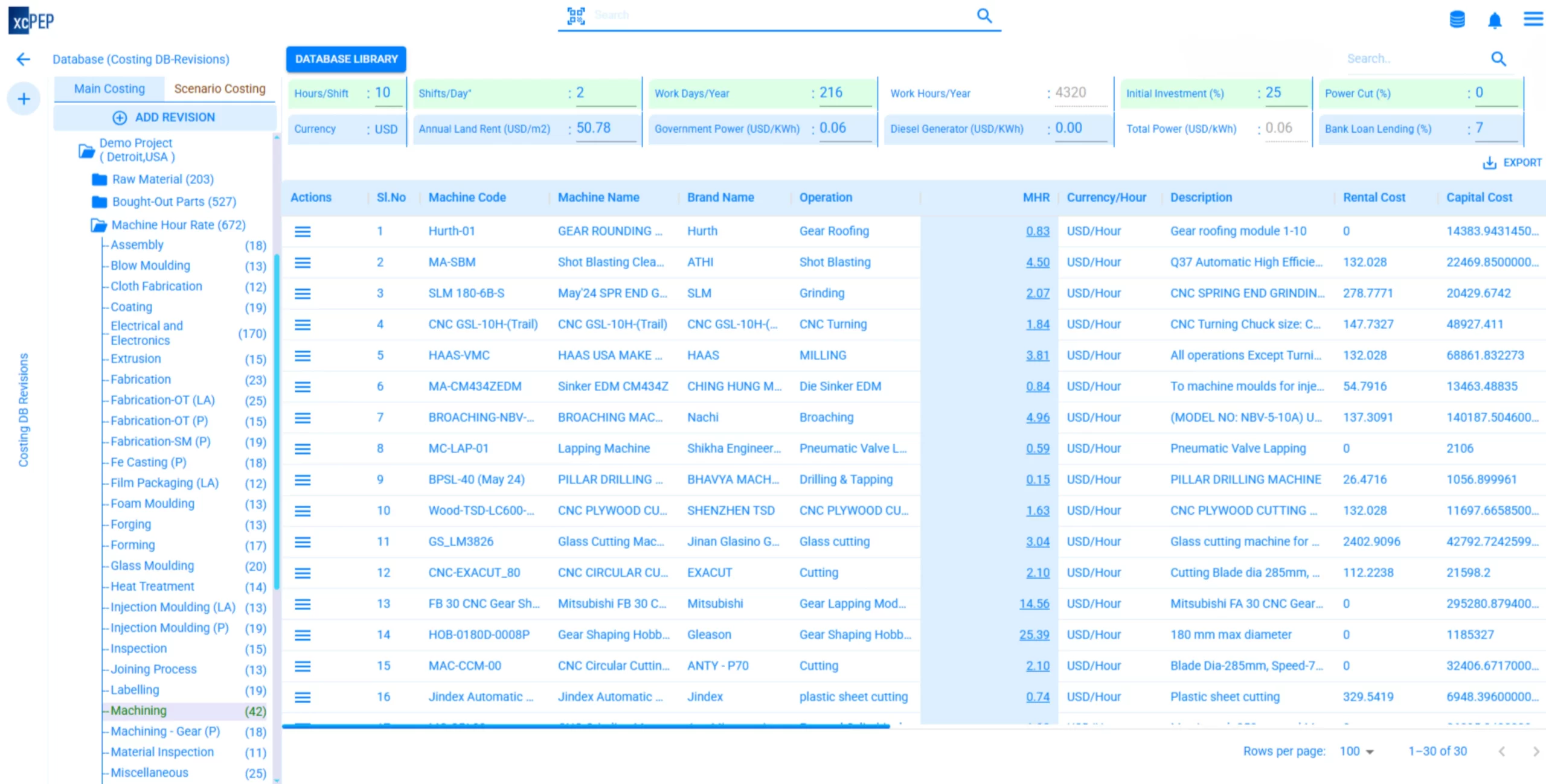
Operations Database
The Operations Database in xcPROC stores cost and rate data for standard manufacturing processes such as machining, welding, coating, heat treatment, and forming. Each operation is linked to relevant parameters like process type, cost unit, and applicable materials or geometries. Unit rates are recorded in engineering-relevant formats such as INR per square meter or INR per kilogram, enabling seamless integration with routing logic in xcPEP. This database supports accurate process selection, supplier comparison, and plant-level cost simulation within should-cost models.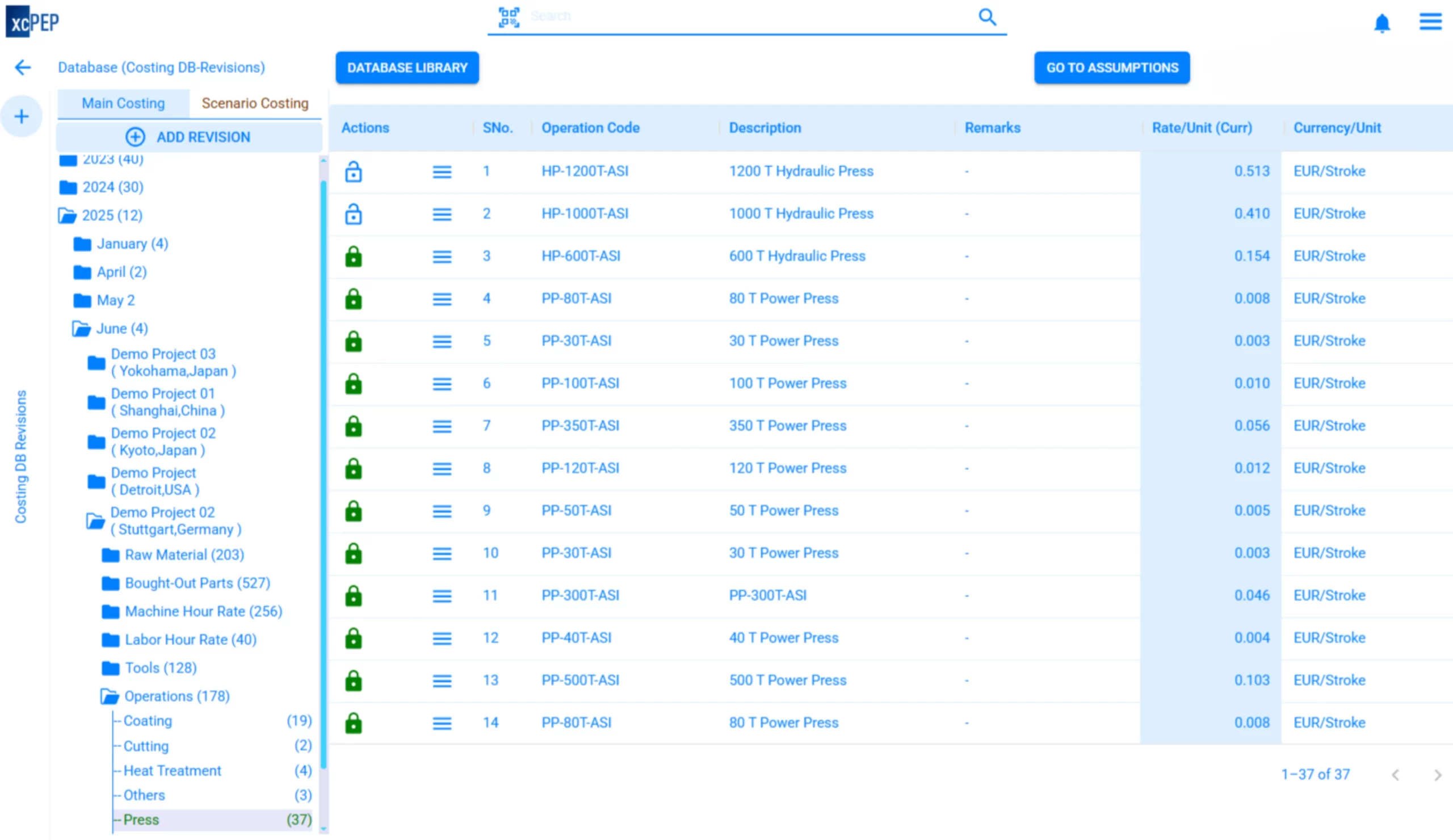
Currencies Database
The Currency Database in xcPROC enables cost calculations to be standardized across global sourcing scenarios. It maintains real-time and historical exchange rates between INR and over 150 international currencies, supporting consistent cost modeling across geographies. This database is essential for converting supplier quotes, material prices, and overhead costs into a single currency view. It allows procurement and finance teams to account for currency fluctuations while maintaining a unified costing baseline within xcPEP.
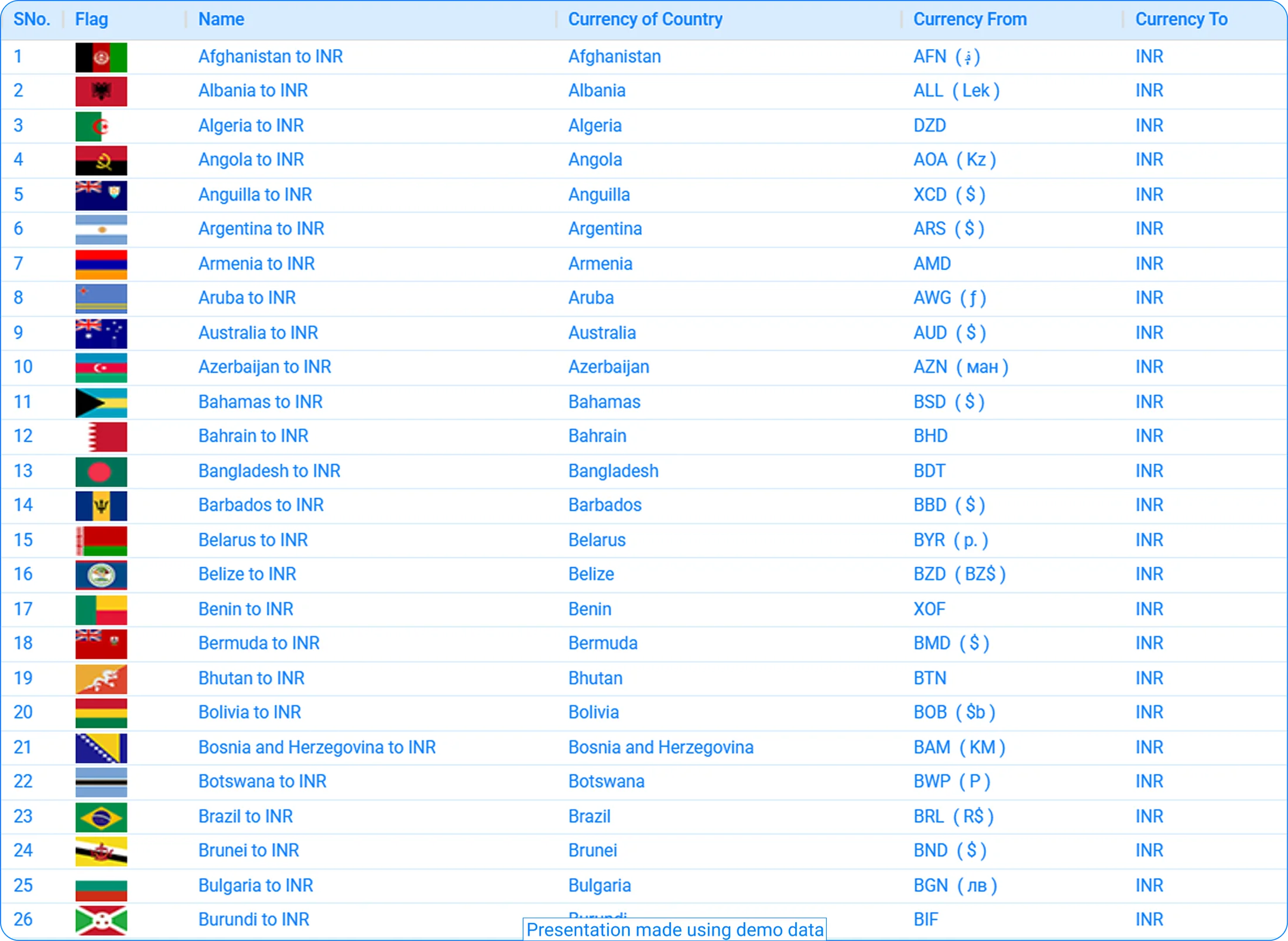
Tools Database
The Tools Database in xcPROC captures tool-level information critical for operations such as assembly, machining, and forming. Each entry includes the tool’s specifications, supplier, material, and category—along with cost and usage life data. This enables tool depreciation to be factored into should-cost models where tooling is a cost driver. The database supports accurate evaluation of part-level tooling costs, especially in cases involving high-volume or custom tooling
.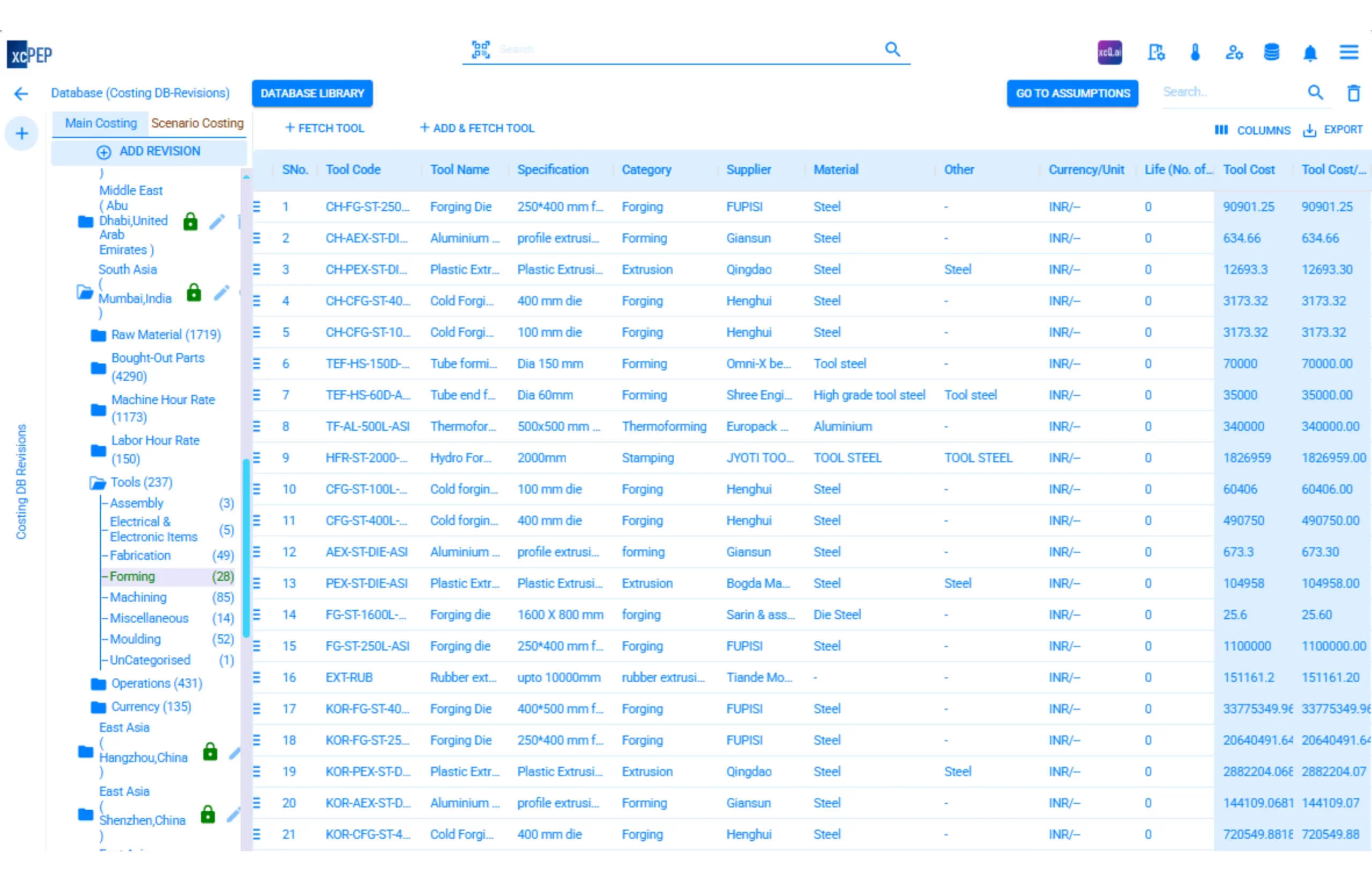
Wage & Salary Database
The Wage and Salary Database in xcPROC provides region-wise labour hour rates essential for calculating accurate manufacturing costs. It includes detailed breakdowns for skilled, semi-skilled, and unskilled labour, covering parameters such as minimum wages, allowances, perks, and total hourly rates. Categorized by industry and process type, this database helps ensure cost models reflect real workforce costs instead of assumptions. It plays a critical role in should-costing exercises, especially in labour-intensive operations like assembly, casting, and fabrication.
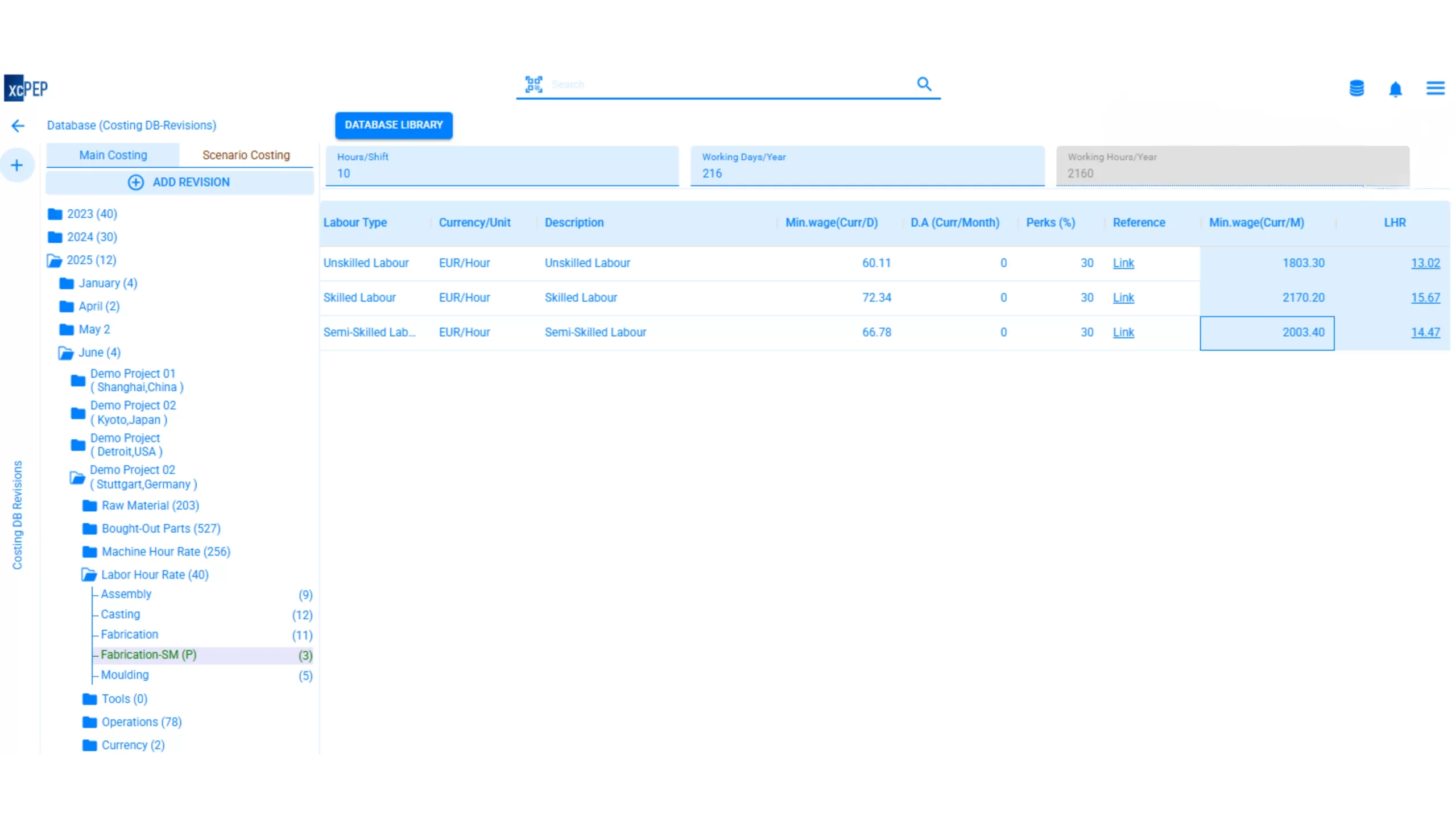
Sample Data
-
Operations Database
-
Supplier Database
-
Parts Database
-
Raw Material Database
-
Machine Database
-
Currencies Database
-
Tools Database
-
Wage & Salary Database
Operation: Painting – Metals
Operation Type: Surface Coating
xcPROC Operation Code: Painting-Metals-35µm
Description: Painting process for metallic parts
Coating Thickness: 35 microns (µm)
Remarks: Cost is calculated per m² for 1 micron of coating thickness
Costing Details
Rate per Unit Thickness: 0.241 USD/m² per micron
Currency/Unit: USD/m²
Effective Cost at 35µm: 8.435 USD/m² (0.241 × 35)
Last Updated: 09 May 2025
Supplier Profile: Uno Minda Limited
Profile URL: View on xcPROC
Company Name: Uno Minda Limited (formerly Minda Industries Ltd.)
Headquarters: IMT Manesar, Gurgaon, Haryana, India
Founded: 1958
Ownership: Publicly listed; part of the NK Minda Group
CIN: L74899DL1992PLC050333
PAN: AAACM1152C
Incorporated Date: 16-09-1992
Company Type: Public Limited Company
Registered Address: B-64/1, Wazirpur Industrial Area, Delhi – 110052, India
Key People: Nirmal K. Minda (Chairman & MD), Sunil Bohra (CFO), Anand Kumar Minda (Director), Rajiv Batra (Director), Satish Balkrishna Borwankar (Director)
Manufacturing Units: 74 across India & global locations
Product Lines: 26 across 4 domains
Last Updated: 08 May 2025
Financial Snapshot (FY 2023 - 24)
Revenue: ₹14,030.89 Cr
EBITDA: ₹1,585.26 Cr
Profit After Tax: ₹880.31 Cr
Gross Turnover: ₹14,030.89 Crores
Export Turnover: ₹845.06 Crores
Total Open Charges: ₹1,559.87 Cr
Product Portfolio
Known Parts: Switches, lighting systems, horns, alloy wheels, seating systems, ECUs, sensors, wiring harnesses, fuse and relay boxes, smart plugs, CAN modules, connectors, terminals, EV chargers, and aftermarket accessories.
Potential Parts: ADAS connectors, camera modules, infotainment housings, steering column switches, sensor hubs, battery control units, smart actuators, EV-specific harnesses, aluminium castings, powertrain wiring modules, and moulded interiors.
Global Operations
Manufacturing Locations: India, Vietnam, Indonesia, Mexico, Germany, Morocco, Colombia
R&D Centers: 37 globally
Export Reach: SAARC, ASEAN, Middle East, Africa, Latin America
Distribution Coverage: 600+ districts and 7,000+ pin codes across India
Certifications
ISO 9001: Quality Management System
IATF 16949: Automotive Quality Management
ISO 14001: Environmental Management System
OHSAS 18001: Occupational Health and Safety
RoHS & REACH Compliance for export markets
Key Customers
Maruti Suzuki, Hero MotoCorp, Honda (2W & 4W), Hyundai, Tata Motors, Mahindra & Mahindra, Bajaj Auto, Toyota Kirloskar, Volkswagen Group, and Renault Nissan
Awards & Recognitions
Cost Leadership Award from Yamaha (2023) for switching system efficiency
Performance Excellence Award from Maruti Suzuki (2023) for lighting quality and delivery
EV Localization Award from Hyundai (2022) for rapid deployment of ECUs and sensors
Technology Excellence Award from Hero MotoCorp (2022) for CAN-based smart switch modules
Contact Information
Corporate Office: Nawada, Fatehpur SikanderPur Badda, IMT Manesar, Gurgaon – Haryana – 122004
Phone: +91 124-2290-693 / +91 124-2290-428
Investor Relations: [email protected]
Careers: [email protected]
Business Enquiries: [email protected]
Media: [email protected]
Part: Capacitor 10 µF – 6.3 V X5R, 0603 SMD
Part Code: JMK107ABJ106MA-T
Commodity: Electronic – Child Parts
Category: Multilayer Ceramic Capacitor (MLCC)
Specification: Ceramic capacitor, 10 µF, ±20% tolerance, 6.3 V rating, X5R dielectric, 0603 (1608 metric) package
Manufacturer: TDK India
Manufacturing Location: Nadia, West Bengal
RoHS Compliant: Yes
Mounting Type: SMD
Package Type: 0603
Application Use: General-purpose decoupling, compact PCBs, filtering applications
Last Updated: May 12, 2025
Technical Specifications
Capacitance: 10 µF
Tolerance: ±20%
Rated Voltage: 6.3 V DC
Temperature Coefficient: X5R
Operating Temp Range: –55°C to +85°C
Length: 1.524 mm
Width: 0.762 mm
Thickness: 0.95 mm
Pricing
1 Qty – ₹9.22 / unit
10 + Qty – ₹5.03 / unit (₹50.30 total)
100 + Qty – ₹2.97 / unit (₹297.00 total)
500 + Qty – ₹2.16 / unit (₹1,080.00 total)
Known Manufacturer
TDK India
Location: Nadia, India
In Stock: Yes, ships immediately
Potential Manufacturers
Samsung Electro-Mechanics India – Bangalore
A global leader in passive components with a strong domestic footprint.
Murata Electronics India
High-precision MLCC supplier for automotive and consumer electronics.
Reference:
Part page on xcPROC: Capacitor - JMK107ABJ106MA-T
Raw Material: Steel – Cast Iron
Material Category: STEEL
xcPROC Material Code: Casting-Cast Iron
Material Grade: Cast Iron
Material Sub-grade: Cast Iron
Density: 7850 kg/m³
Description: Standard cast iron used in sand casting applications for industrial parts. Known for high castability, machinability, and thermal mass, making it ideal for engine blocks, housings, and heavy equipment components.
Price Range
Raw Material Cost / Ton: 356.05 USD/ton
Raw Material Cost / Kg: 0.35605 USD/kg
Price Source: SIAM
Scrap Cost / Ton: 142.42 USD/ton
Scrap Cost / kg: 0.14242 USD/kg
Price Source: SIAM
Currency: USD
Currency Conversion: Real-time INR/USD database available in xcPROC
Unit: Metric Ton (MT) & Kilogram (kg)
Last Updated: 08 May 2025
Market Insights: Steel in China
China is the world’s largest steel producer, accounting for over 50% of global steel output
Domestic steel demand remains strong, but government-led green transition policies are reshaping production capacities and shifting focus toward low-emission, high-strength grades.
Prices in China are highly sensitive to government stimulus, construction activity, and raw material imports (especially iron ore from Australia and Brazil).
Major Steel Suppliers in China
China Baowu Steel Group
HBIS Group
Ansteel Group & Shagang Group
Injection Moulding Machine Details
Machine Name: Injection Moulding 2400 Ton
Machine Code: IMM-2400 T
Brand Name: HAITIAN
Operation: Injection Moulding
xcPROC Commodity Type: Injection Moulding (P)
Description: HAITIAN-HA 2400 T Injection Moulding Machine with a high injection rate of 1867 g/s, ideal for producing large plastic components and multi-cavity moulds with precision and repeatability.
Machine Insights
Designed for high-volume production in the automotive, appliance, and packaging industries.
Equipped with advanced servo-hydraulic technology ensuring energy efficiency and process consistency.
With an injection rate of 1867 grams per second, it is capable of handling large shot weights and complex tooling.
Cost Details
Capital Cost: $ 411,807.01
Installation Cost: $ 41,180.701
Consumable Cost: 5%
Maintenance (% per year/shift): 5%
Life Expectancy: 10 years
Effectiveness: 80%
Last Updated: 09 May 2025
Power & Footprint
Average Power Consumption: 416 kWh
Peak Power Factor: 0.8
Machine Bed Area: 88.508 m²
Reference Links
Product Reference: HAITIAN HA 2400 T PDF
Currency Database – USD to INR
Base Currency: USD (United States Dollar)
Target Currency: INR (Indian Rupee)
Current Exchange Rate: 1 USD = ₹85.42 INR
Last Updated on: 12 May 2025
Quick Conversion Reference
$1 USD = ₹85.42 INR
$10 USD = ₹854.20 INR
$100 USD = ₹8,542.00 INR
$1,000 USD = ₹85,420.00 INR
Exchange Rate Overview
Today's Rate: ₹85.42 per USD
7-Day Range: ₹84.20 – ₹86.08
Monthly Average (May 2025): ₹84.86
Last updated on: 12 May 2025
Injection Moulding Tool
xcPROC Tool Code: TOOL-IM-BUMP-4C
Tool Name: 4 Cavity Bumper Mould
Tool Type: Injection Mould
Operation Supported: Plastic Injection Moulding
Supplier: Shanghai Precision Toolworks Co. Ltd.
Material: P20 Pre-Hardened Steel
Built In: China
Tool Description: High-precision multi-cavity tool designed for large plastic automotive bumpers. Built for high-volume production with integrated cooling and ejection systems.
Cost & Lifecycle
Tool Cost: USD 62,000
Tool Life: 300,000 shots
Tool Material: P20 steel (hardened)
Manufacturing Lead Time: 7–9 weeks
Maintenance Interval: Every 30,000 shots
Labour Hour Rate – Cleveland, Ohio
Hours/Shift: 8
Working Days/Year: 281
Working Hours/Year: 2,248
Labour Categories & Hourly Rates
🔹 Skilled Labour
Labour Code: SK-LAB
Description: Skilled Labour
Currency/Unit: USD/Hour
Minimum Wage (Monthly): $3,595.20
Perks: 30%
Labour Hour Rate: $24.95/hour
🔹 Semi-Skilled Labour
Labour Code: SSK-LAB
Description: Semi-Skilled Labour
Currency/Unit: USD/Hour
Minimum Wage (Monthly): $3,081.60
Perks: 30%
Labour Hour Rate: $21.38/hour
🔹 Unskilled Labour
Labour Code: UNSK-LAB
Description: Unskilled Labour
Currency/Unit: USD/Hour
Minimum Wage (Monthly): $2,567.40
Perks: 30%
Labour Hour Rate: $17.82/hour
Notes:
LHR (Labour Hour Rate) is derived from monthly wage, perks, and annual working hours.
Currency: USD
Location: Cleveland, Ohio (U.S.)
Last Updated: 08 May 2025
xcPROC Successes
As deployed directly by ASI for its customers
Vendor Base Development for New Setup
As part of a new product development program, xcPROC was deployed to identify and evaluate suppliers for a greenfield sourcing requirement. The platform enabled data-backed shortlisting based on manufacturing capabilities, financial performance, debt levels, quality certifications, export exposure, plant locations, customer associations, and ownership details. ASI used this data to prepare negotiation fact packs that supported structured, transparent discussions with potential vendors. The process accelerated supplier qualification and reduced onboarding time—ensuring that sourcing decisions were based on verified and contextual inputs, not assumptions.
Alternate Vendor Identification based on Manufacturing Capabilities
xcPROC was deployed to help a client identify alternate suppliers for critical components where existing vendors lacked the required capacity or flexibility. Using part-level capability mapping, xcPROC matched potential manufacturers based on machines, supported processes, certifications, and plant infrastructure—allowing the sourcing team to shortlist technically feasible alternatives without restarting the qualification cycle. In addition to part-specific suggestions, the client used the Supplier Database to independently explore and filter vendors by region, capability, and financial health. This ensured supply continuity, reduced risk, and enabled better location-based sourcing decisions.
Raw Material and other rate update for xcPEP Subscribers
xcPROC is deployed for all xcPEP subscribers to keep core cost inputs updated without manual effort. Raw material prices, currency rates, labour hour costs, and machine hour rates are revised on a defined schedule based on the type of dataset and client preference. This ensures that all should-cost models in xcPEP remain aligned with current market conditions. The integration also enables scenario costing, helping teams simulate changes and make sourcing decisions using real time, cost data.
Developing and exporting parts from Indian vendors
xcPROC was deployed to support the development and export of parts from Indian manufacturers. The platform enabled structured identification and evaluation of qualified suppliers by leveraging detailed profiles covering technical capabilities, financial disclosures, certifications, plant locations, and customer history. This approach streamlined the supplier shortlisting process for export readiness and ensured that sourcing decisions were based on validated, application-specific data. The deployment helped build a reliable vendor base for international programs while supporting end-to-end supplier discovery, assessment, and onboarding within the same environment.
FAQs
Vast Library and Customer Specific Customizations
Most cost‑data platforms rely on “industry‑average” libraries, generic tables, hidden multipliers, and one‑size‑fits‑all assumptions that can distort a should‑cost model by double digits. xcPROC, backed by ASI’s dedicated data research team and decades of cross‑industry cost‑engineering experience, replaces those averages with part‑specific data and transparent, auditable cost logic.
Below are the most common questions we hear from engineers, buyers, finance leaders, IT security specialists, and compliance officers evaluating xcPROC and xcPEP against traditional cost‑data systems.
Who collects and maintains the data inside xcPROC?
All data in xcPROC is built and maintained by ASI’s dedicated data research team. It draws on years of cost-engineering experience, industry-specific project work, and continuous research to ensure high accuracy, technical relevance, and real-world applicability.
Do you sell the xcPROC database as a standalone product?
No. Full access to xcPROC is provided only when you deploy xcPEP in your organization or partner with ASI for a cost-reduction or should-costing project. The database is not sold separately or licensed in isolation.
Can you build custom databases for us?
Yes. We regularly develop fully customized datasets tailored to a client’s specific parts, processes, and geographies. Whether it's a new material type, region-specific wage structure, or a niche manufacturing operation, our data research team builds it from the ground up. These datasets are maintained exclusively for your organization, updated as needed, and securely hosted in your private xcPROC workspace. They can also be directly integrated into xcPEP cost models used in your projects.
How frequently is the data updated?
xcPROC is continuously updated through a combination of internal improvement cycles and project-driven updates. Core datasets like raw materials, currency, and wages are regularly refreshed to reflect market changes. For client-specific databases, updates are made as per project requirements and direct inputs from the client.
How is xcPROC different from generic cost databases?
Generic cost‑data platforms lean on industry‑average tables and blanket multipliers that ignore routing variations, regional cost drivers, and part‑specific operations—numbers that often crumble in negotiations or audits. xcPROC replaces those assumptions with granular, part‑level data tied to real manufacturing context—tooling, cycle times, material yields, and live market rates. The result is a transparent, defensible cost model that mirrors shop‑floor reality and drives accurate, negotiation‑ready should‑costs.
